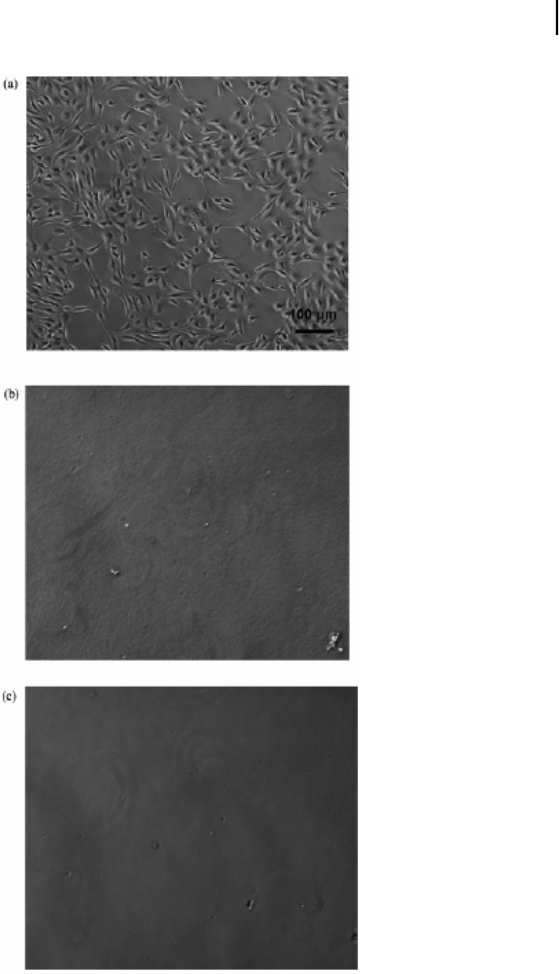
190 K.Yu,G.GaoandJ.N.Kizhakkedathu
Figure 8.18. Illustration for the process of surface grafting via ATRP from the silanized
glass surface covered with initiators. Images adapted from Ref. 103.
for the statistical copolymer brushes formed from a 1:1 homogeneous reaction
mixture of the two oppositely charged monomers.
8.4 POLY(METH)ACRYLATE BASED NON-FOULING SURFACES
Genzer et al. used assemblies of surface-bound poly(2-hydroxyethyl methacrylate)
(PHEMA) brushes with gradual variation of molecular weight and/or grafting
density to vary the amount of adsorbed fibrinogen.
109
They achieved a gradient
of adsorbed fibrinogen on the surface by changing the molecular weight and graft
density with least fibrinogen adsorption found at maximum PHEMA coverage.
Cell culture studies using MC-3T3 E1 cells on these surfaces showed that cell
morphology and density can be varied as function of fibrinogen (and hence
PHEMA) coverage (Fig. 8.20).
Ignatova and J´erˆome synthesized copolymer brushes by a two-step “grafting
from” method that consisted of a) electrografting of poly(2-phenyl-2-(2,2,6,6-
tetramethyl-piperidin-1-yloxy)-ethylacrylate) onto stainless steel b) the nitroxide-
mediated radical polymerization of 2-(dimethylamino ethyl)acrylate and styrene
or n-butyl acrylate initiated from the electrografted polyacrylate chains.
110
The
grafted copolymer brushes were quaternized to make them anti-bacterial. Quartz
crystal microbalance experiments have proven that fibrinogen adhesion was lower
on the hydrophilic quaternized films compared to the nonionic counterpart. Also,
the quaternized copolymer surfaces exhibited significant antibacterial activity
against the gram-positive bacteria S. aureus and the gram-negative bacteria E. coli
8.5 POLY(METH)ACRYLAMIDE BASED NON-FOULING SURFACES
Poly(N-isopropylacrylamide) (PNIPAAm) is a water-soluble thermo-responsive
polymer. PNIPAAm has a lower critical solution temperature (LCST) at about
SO13997_text.indd 198SO13997_text.indd 198 26/01/2011 3:50 PM26/01/2011 3:50 PM

Polymer-Based Biocompatible Surface Coatings 191
Figure 8.19. Cell culture on different surfaces: (a) control glass, (b) glass grafted with
polySBMA, and (c) glass grafted with polyCBMA. Images adapted from Ref. 104.
32
◦
C in an aqueous solution. It assumes a random coil structure (hydrophilic state)
below the LCST and a collapsed globular structure above the LCST (hydrophobic
state).
111−115
Because of this unique property, surfaces grafted with PNIPAAm
were used for controlled cell adhesion studies. Kang et al. synthesized well-
defined functional polymer-Si hybrids, consisting of covalently tethered brushes
SO13997_text.indd 199SO13997_text.indd 199 26/01/2011 3:50 PM26/01/2011 3:50 PM

192 K.Yu,G.GaoandJ.N.Kizhakkedathu
Figure 8.20. Left: contour plots of a) dry thickness of PHEMA in a MW-σ orthogonal
PHEMA gradient (scale in nm); b) dry FN thickness in a MW-σ orthogonal PHEMA/FN
gradient (scale in nm), the scales depicting the position on the substrate in parts (a) and
(b) are in cm. Right: fluorescence microscopy (10x) images of fluorescently labeled MC3T3-
E1 cells (nucleus: DAPI blue, cytoskeleton/actin: phalloidin red) cultured on PHEMA/FN
gradient substrates. Images were taken at positions on the PHEMA/FN gradient sample
marked with the numbers in part (b). The error bars associated with the thickness measure-
ments (≈ 0.1 nm) are smaller than the thickness increments in the contour plots. Images
adapted from Ref. 109. For color reference, see page 271.
of POEGMA, PNIPAAm and poly (NIPAAm-OEGMA) copolymers and block
copolymers on silicon surfaces via surface-initiated ATRP.
116
Cell adhesion was
evaluated by culturing the cell line 3T3-Swiss albino on the hybrid surface. As
to PNIPAAm grafted silicon surface, at 30
◦
C (above the lower critical solution
temperature of NIPAAm), the seeded cells adhered, spread, and proliferated on
the NIPAAm graft polymerized silicon surface. Below the LCST, the cells detached
from these surfaces spontaneously. Incorporation of POEGMA units into the
NIPAAm chains of the Si-g-PNIPAAm surface via copolymerization resulted in
more rapid cell detachment during the temperature transition.
Our group utilized aqueous ATRP to graft a series of cleavable hydrophilic
PNIPAAm homopolymers and block copolymers of substituted acrylamides from
polystyrene latex to give brushes of controlled MW and surface density.
117
Expo-
sure to radiolabeled single proteins or to whole plasma and subsequent analysis
by SDS-PAGE showed that PNIPAAm brushes decreased protein adsorption rel-
ative to the latex surface or other substituted polyacrylamides. The PNIPAAm
brushes exhibited a second-order phase transition around 30
◦
C as reflected by a
decrease in the hydrodynamic thickness of the brush at higher temperatures. Total
plasma protein adsorption was increased at 40
◦
Ccomparedto20
◦
C but there was
significant differential adsorption behavior among the proteins detected by gel-
electrophoresis analysis.
SO13997_text.indd 200SO13997_text.indd 200 26/01/2011 3:50 PM26/01/2011 3:50 PM
Get Biomaterials for MEMS now with the O’Reilly learning platform.
O’Reilly members experience books, live events, courses curated by job role, and more from O’Reilly and nearly 200 top publishers.

